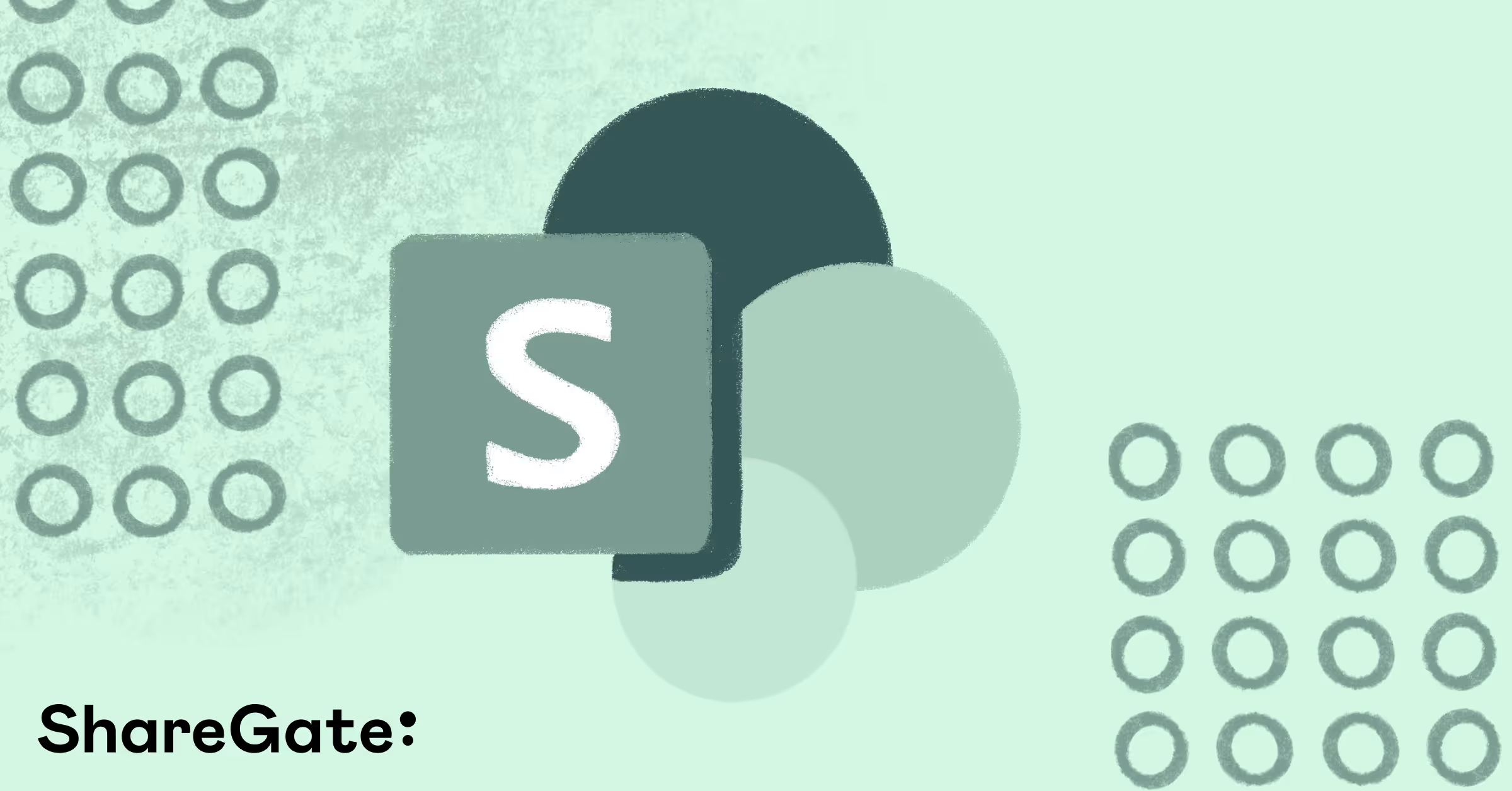Two ways to migrate Microsoft Teams from one tenant to another

Table of contents
Trying to migrate Teams resources from one tenant to another? We explain two ways to tackle your Teams tenant to tenant migration—ensuring users have everything they need to succeed in their new environment.
Thinking about migrating teams? Check out how the ShareGate SharePoint Migration tool compares to Microsoft's SPMT.
Microsoft Teams has become a powerhouse for communication and collaboration with the M365 environment — with new and improved features, an easy-to-use interface, and seamless integration with other Microsoft tools.
With the content created in Teams now more valuable than ever, the ability to migrate this data as needed is no longer a nice to have; in the context of a merger or acquisition, it’s a critical process to ensure our workflows also transition with us seamlessly.
Here at ShareGate, we’re well-known for our SharePoint migration tool. Since Teams lives in the same Microsoft 365 ecosystem, we’ve gotten many questions from our customers about how to migrate their Teams environment to a new tenant, as well.
Ensure your Teams tenant-to-tenant migration is a success by checking out our complete Guide to Teams Migration ebook. We cover everything before, during, and after migration in a simple, easy-to-read guide plan.
When a Microsoft Teams tenant-to-tenant migration is useful
There are several scenarios that necessitate migrating Teams data across tenants. Here are some common examples:
- Mergers and acquisitions: Combining Microsoft Teams environments into a single tenant simplifies communication and collaboration during mergers.
- Divestiture: If part of your organization is spun off, you must migrate relevant Teams data and workflows to the new entity's tenant.
- Tenant consolidation: Consolidating multiple Teams tenants into one simplifies administration and reduces costs.
Microsoft doesn't currently offer a built-in tool for direct tenant-to-tenant migration for Teams. However, it is finding ways to simplify the process through its cloud solution, Microsoft 365. To address this gap, you can use third-party Office 365 migration tools or utilize PowerShell scripts for the migration process.
Understanding the challenges of Teams tenant-to-tenant migration
Migrating Microsoft Teams data between tenants can be complex due to several factors. Here's a breakdown of the key challenges:
- Data fragmentation: Unlike some collaboration tools, Teams data isn't stored in a single location. It's scattered across various Microsoft services like SharePoint, Exchange, OneDrive, and more. This fragmentation adds a level of complexity to the migration process.
- Limited third-party tool support: While third-party tools exist for migrating Teams data, not all offer comprehensive support. Some may have limitations in functionality, security, or scalability, making it crucial to choose the right tool for your needs.
- Evolving Microsoft 365 environment: The M365 environment constantly evolves, with new features being added to Teams regularly. Maintaining compatibility between the source and destination tenants, especially during long migrations, can be challenging.
- User adoption and training: A successful migration goes beyond just transferring data. Ensuring user adoption and providing adequate training in the new Teams environment minimizes disruption and maximizes productivity. This may involve creating training materials, offering change management strategies, and establishing ongoing support channels.
Option #1: Migrate Microsoft Teams from one tenant to another manually
Migrating Microsoft Teams data to another tenant manually involves multiple steps and a ton of heavy lifting on the part of IT.
Technically, there’s no easy, out-of-the-box way to migrate Teams between Office 365 tenants. However, you can move some underlying components into the team's Exchange mailbox, such as the files stored on the associated team SharePoint site, group chat, and channel conversation history.
While there are several different ways to do this, we will walk you through one of the most straightforward methods that doesn’t involve third-party tools. This method requires technical expertise and significant time investment. While it offers complete control over the process, be prepared for a hands-on approach.
Note: While possible, manually migrating Microsoft Teams data between tenants is not recommended for large or complex migrations due to the time investment and potential for errors. It's a better-suited option for smaller deployments with a limited number of Teams and users.
Here's a detailed overview of the key steps to guide you through a manual migration:
Step#1: Preparation
First, you’ll need to define your migration goals and take stock of your Teams environment. Here's what you need to do:
Define your migration goals
It’s important to clearly outline what you want to achieve with this migration. Are you moving all Teams and their data, or just specific ones? Do you need to migrate chat history, permissions, or specific channels? Having a defined scope helps you stay focused and avoids unnecessary or redundant work.
Identify source and target tenants
Determine the exact names and domains of both your source tenant (where the Teams data is currently located) and target tenant (where you want to move the data). This will be crucial information throughout the migration process.
Take inventory of your Teams
Create a list of all the Teams you plan to migrate. Include details like Team names, number of channels, and specific notes about permissions or content. This inventory will act as a roadmap and ensure you don't miss anything during the migration.
User mapping
Plan how to map users from the source tenant to the target tenant. Ideally, usernames and email addresses should be identical to minimize configuration issues. If not, you must create a mapping document that links source and target user accounts.
Step#2: Migration process
In this step, you’ll put your plan into action. Here’s how:
Team recreation
In your target tenant, manually recreate the same Teams structure you have in the source tenant. This includes creating the Teams, setting up channels within each Team, and replicating the basic structure.
User management
Add the corresponding users from the source tenant for each recreated Team. If usernames differ, utilize your user mapping document. Things can get time-consuming here: you'll need to assign appropriate permissions to each user within the Team. This might involve replicating owner, member, or guest access levels from the source Teams.
Content migration
Moving your files, folders, and documents is also part of the process. Luckily, you can access and download this content directly from the associated SharePoint sites in your source tenant. Here's how to do it for smaller migrations:
- Each Team in Microsoft Teams has an associated SharePoint site that stores files, folders, and documents. Access the SharePoint sites for each Team in your source tenant. Download the desired content (files and folders) from the relevant locations (like the "General" folder).
- In your target tenant, navigate to the corresponding SharePoint sites for the newly created Teams. Upload the previously downloaded content to the appropriate locations within these sites.
Note: This method only works for files and folders. You won't be able to migrate entire SharePoint pages or lists, and some metadata associated with the files might be lost during the process.
Chat history export (using PowerShell)
To capture your team’s conversations, we’ll use PowerShell scripting to export chat history from the group mailboxes linked to each Team in your source tenant. It might sound technical, but don’t worry—we’ll guide you through each step!
- Microsoft Teams chat history resides within the group mailbox associated with each Team. To access this data, you'll need to use PowerShell scripting. Ensure you have the necessary permissions and connect to Exchange Online PowerShell in your source tenant.
- Run PowerShell commands to list all group mailboxes in your source tenant. This will help you identify the specific mailboxes linked to the Teams you want to migrate.
- For each target Team, use specific PowerShell commands to export the chat history from the corresponding group mailbox in your source tenant. This data will likely be saved as a .pst file. While Microsoft doesn't offer specific commands for exporting chat history directly, it provides a script for exporting mailbox data that can be adapted for this purpose. You can find this script here.
- The exported chat history might not be readily accessible to users. You can convert the .pst file to a more user-friendly format, like a PDF document, for easier reference.
- Upload the converted chat history documents to the corresponding "General" folders within the newly created Teams' SharePoint sites in your target tenant. This will make the chat history accessible to team members alongside other relevant files.
Remember:
- Manual migration is a complex process with many repetitive steps. Be prepared to invest significant time and effort, especially for large deployments with many Teams and users.
- Technical expertise with PowerShell scripting is crucial for successful data extraction and configuration in the target tenant.
- This method has limitations. It might not transfer all data elements flawlessly, like permissions or metadata associated with files.
- While a manual migration offers complete control, it requires significant resources and technical knowledge. If efficiency and minimizing downtime are priorities, exploring a third-party tool like ShareGate might be a more suitable option.
Option #2: ShareGate’s tenant-to-tenant migration tool
While manual migration is certainly an option, it's often an impractical one for most organizations due to its limitations. ShareGate’s easy-to-use tenant-to-tenant migration tool can offer a more efficient and reliable alternative for migrating Teams data between tenants.
Here's a look at how ShareGate simplifies the Teams tenant-to-tenant migration process:
1. Automated migration
ShareGate automates the entire migration process, eliminating the need for repetitive manual tasks like scripting and data transfer. The tool offers a user-friendly interface for selecting specific teams, channels, and data types for migration.
2. Comprehensive data transfer
ShareGate migrates all essential Teams data components, including:
- Team settings and descriptions
- Memberships (owners and members)
- Permissions
- Conversation history (including sender, threaded messages, links, and timestamps)
- Public channels
- Lists
- Files (along with their version history and metadata)
- Tabs
- Apps and bots (those available in the App Store)
- SharePoint site customizations
- Default wiki pages
- OneNotes
3. User mapping and permissions
ShareGate automatically maps users at the destination tenant, ensuring the right people can access the right teams with the correct permissions. This eliminates the need for manual user configuration.
4. Streamlined workflow
ShareGate's intuitive interface guides you through the migration process step-by-step. You can select specific teams and channels for migration, schedule migration times to minimize disruption, and receive detailed reports on the migration status.
5. Additional benefits
- Reduced downtime: ShareGate minimizes user downtime by efficiently transferring data between tenants.
- Improved accuracy: Automating the tenant-to-tenant migration process reduces the risk of human error compared to manual methods.
- Scalability: ShareGate can easily handle large-scale migrations, making it suitable for organizations of all sizes.
- Ongoing support: ShareGate provides comprehensive support resources and a knowledgeable team to assist you throughout the migration process.
Here's a step-by-step example of using ShareGate to migrate Teams:
- Navigate to the "Copy" screen within ShareGate and select the "Copy Teams" option.
- Connect to the source tenant and select the specific Teams and channels you want to migrate.
- Choose the destination tenant and specify whether you want to create new Teams or migrate them to existing Teams. ShareGate also identifies potential conflicts (like duplicate team names) and helps you resolve them before migration.
- Select a convenient time for the migration and initiate the process. ShareGate provides progress reports throughout the migration.
- Once the migration is complete, ShareGate generates a detailed report summarizing the process and highlighting any potential issues.
Ready to start your migration? Here’s a walk-through of how to get started with copying Teams and their channels to easily reorganize and restructure your organization.
Migrating Microsoft Teams from one tenant to another can be challenging. You have two primary options: manual migration or a third-party tool like ShareGate. Manual migration is cost-free but time-intensive and requires high technical expertise. Moreover, it may not transfer all data elements perfectly.
Meanwhile, ShareGate offers a more automated and user-friendly approach. It can migrate all critical Teams data, including chat history, files, permissions, etc. Hence, this minimizes downtime and reduces the risk of errors.
When planning a Teams tenant-to-tenant migration, carefully consider your options and choose the one that aligns best with your needs and resources.
FAQs
Thinking about moving your Microsoft Teams to a new tenant? This FAQ section is your quick reference guide to help you navigate the process, from understanding the "why" to ensuring your team stays in the loop. Let's get you migrated smoothly!
Why would I need to migrate my Microsoft Teams data to a new tenant?
There are several reasons for a Teams tenant-to-tenant migration. You might be consolidating multiple tenants, restructuring your organization within Teams, or moving to a new Microsoft 365 subscription.
What are the limitations of manual migration?
While manual migration offers a free approach, it's complex and time-consuming. It requires technical expertise, can be error-prone, and might not capture all data elements, such as metadata or version history.
How does ShareGate simplify the Teams tenant-to-tenant migration process?
ShareGate simplifies the Teams tenant-to-tenant migration process by automating tasks like user migration, content transfer, and permission management, minimizing manual effort and downtime.
How do I handle user training and adoption post-migration?
A successful migration goes beyond just transferring data. Successfully managing user training and adoption post-migration involves several key steps:
- Communicate clearly: Inform users about the upcoming migration, its purpose, and the timeline.
- Provide training resources: Offer user guides, video tutorials, or live training sessions to familiarize them with the new Teams environment.
- Encourage exploration: Promote the new features and functionalities of Teams to incentivize user engagement.
- Gather feedback: Actively seek user feedback after the migration to address any concerns or challenges.
.jpg)


.svg)
.avif)
%20(1).avif)












.jpg)


.png)

